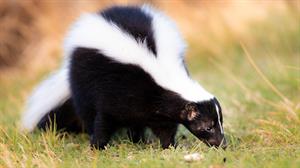Encountering a skunk can be an unsettling experience, especially due to their well-known defensive mechanism – spraying a foul-smelling liquid. Skunks are generally non-aggressive and resort to spraying only when they feel threatened. Understanding the appropriate steps to take during such an encounter can significantly minimize the risk of being sprayed and ensure the safety of both you and the skunk. In this blog, we will walk you through detailed steps to handle this delicate situation should you find yourself in close proximity to a skunk.
Stay Calm and Move Slowly
The first and most crucial step when you encounter a skunk is to remain calm. Skunks are very sensitive to sudden movements and can spray as a reflex when startled. If you spot a skunk, it is important to move slowly and quietly to avoid alarming it. Refrain from making direct eye contact, as skunks can perceive this as a threat. By maintaining calm and controlled movements, you can greatly reduce the chances of triggering a defensive reaction, giving you the opportunity to safely withdraw from the encounter.
Keep Pets at a Safe Distance
Pets, especially dogs, can become overly curious and may inadvertently provoke a skunk, leading to an unpleasant spraying incident. If you are accompanied by your pet, keep them on a tight leash and quietly guide them away from the skunk. Training your pets to respond to commands quickly and obediently is crucial in managing their interactions with wildlife. This precaution helps prevent them from startling the skunk and becoming a direct target of its spray.
Use Light as a Deterrent
Skunks are nocturnal creatures with relatively poor eyesight, relying more on their senses of smell and hearing to identify threats. If you encounter a skunk during nighttime, a gentle use of a flashlight can serve as an effective deterrent without causing panic. The light not only disorients the skunk but also gives you better visibility, thereby facilitating a safer exit strategy from the situation. Ensure the light is not too intense as it could further scare the skunk and lead to defensive spraying.
Provide an Escape Route
One critical strategy when dealing with skunks is ensuring they do not feel cornered. These creatures are more likely to spray when they perceive no escape. Always be mindful of the skunk’s position and ensure it has a clear and accessible escape route. By strategically positioning yourself and any companions in a way that does not obstruct these paths, you encourage the skunk to leave the area peacefully without resorting to its defense mechanism.
If Sprayed, Act Quickly to Remove the Odor
In the unfortunate event that you or your pets gets sprayed, immediate action is necessary to effectively remove the odor. Quickly prepare a mixture of hydrogen peroxide, baking soda, and dish soap to treat the affected area. This solution is particularly effective as it breaks down the oil-based spray, making it easier to wash off. It is important to apply this mixture before using water, as water alone can cause the odorous oils to penetrate deeper into fabrics and fur. Remember to use protective gloves and possible goggles to avoid irritation from the skunk’s spray during cleanup.
Contact Hopper Termite & Pest Today
Handling encounters with skunks or other wildlife can seem daunting, but knowing the right steps can greatly alleviate the stress of such situations. At Hopper Termite & Pest, we pride ourselves on providing expert solutions for all kinds of pest and wildlife challenges, including skunks. Our experienced team is dedicated to ensuring that your home remains a safe and welcoming space for you and your family. Should you need advice or professional assistance, do not hesitate to contact our Springdale office at (479) 750-4070 or our Mountain Home office at (870) 425-4122. From termites to rodents and everything in between, our services are designed to handle every pest control need efficiently and safely.


Recent Comments